
Every time I play Xevious on one of Namco’s "museum" compilations, I can’t help but reminisce about the time when I first discovered the game in 1992 on the Atari 7800 (a system which also familiarized me with other Namco classics outside of Pac-Man). Back then, our family couldn’t afford the Super NES or Sega Genesis. So, in a move of what I think was out of pity, a friend of ours gave us her 7800 with a huge bag full of games. While rummaging through the cartridges, I came across the little oddity known as Xevious. It was probably the first game I had heard of that started with an “X”, and the name intrigued me. I quickly fell in love with the unique enemy designs and mysterious land structures peppered throughout the game.
Over the years, after discovering websites dedicated to retro gaming, I was pretty happy to find out that Xevious was more than just a random title on an Atari system. It was well known by fans everywhere as one of the most innovative arcade games of its time. In a 1985 interview, the game’s designer, Masanobu Endo, said that he wanted to make “a consistent world and setting, create high-quality sprites”, and also “a story that wouldn’t just be some tacked-on extra, but could actually stand on its own merits”. When it was released in arcades in 1983, Xevious went on to become the game that forever changed the landscape of 2D shooters.
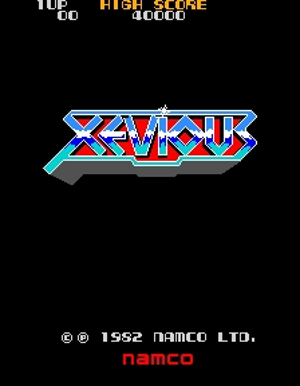
If you’ve ever read the story elements of this game, then you already know that Xevious spins a tale rife with twists and turns. But I’ll do my best to keep it simple. Basically, a war breaks out between humankind and the bio-computer GAMP (General Artificial Matrix Producer)- a machine capable of mass-producing human clones. The GAMPs grew tired of humans using them for joyless slave labor. So they rebelled, vacated Earth, and traveled to the planet Xevious where they hatched a plot against mankind. Thousands of years and one ice age later, the GAMPs return to Earth to enslave humans and take over the planet. It’s up to you to pilot the Solvalou ship and defend Earth against its would-be conquerors.
The core design elements of Xevious outpaced that of arguably every other shooter that came before it. It went a step further than just blasting the same simplistic set of bug-like creatures off the screen. You had two separate weapons. First, there’s the zapper- dedicated to destroying aerial enemies. You also have the blaster- an unlimited supply of bombs used to take out ground targets with the help of a targeting reticle in front of your ship. Having separate weapons for aerial and ground enemies introduced a new layer of strategy. As attacks from enemies increase, it may not always be advantageous to go after everything on the screen. As a result, players often found themselves having to choose the best course of action under the circumstances.
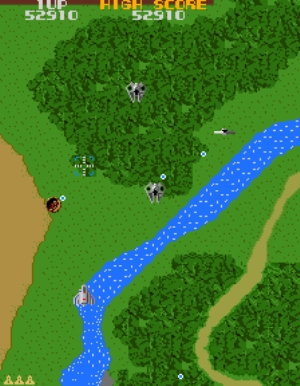
Xevious also brimmed with personality in an unprecedented way. The game was chock-full of quirky nuances that were rarely (if ever) seen in a scrolling shooter at the time. The aerial enemies that invade the screen had some rather intricate designs and impressively realistic attack patterns. Previously in fixed-screen shooters like Space Invaders, enemies marched in the same simplistic pattern. Or in games like Galaxian and Galaga, the space bugs were constantly doing kamikaze dives, attempting to crash into your ship. But in Xevious, enemies will swoop in to fire a quick shot and then retreat away from you. Endoh designed the enemies that way since he figured that real fighter pilots wouldn't want to just collide with the enemy if it could all be avoided. It was a subtle, yet smart design choice that made the action on-screen all the more believable.
In total, there are 16 different sections in the game. Dense forest areas mark the boundary between sections. Some areas culminate into a battle with the Andor Genesis- an imposing giant mothership. It is considered to be one of the earliest examples of an end level boss in a scrolling shooter. It seemed like there was always something new being thrown at you. Whether you’re surrounded by rotating ships (Zoshi), weaving through invincible floating shields, avoiding shrapnel released from exploding bombs, or flying over Nazca lines etched in the ground below, there was plenty to see in Xevious.
This game also introduced a form of artificial intelligence that adapted to your skill. As you get better at destroying enemies, new swarms will appear with increasingly versatile attack patterns. So to an extent, the more aggressively you play, the more the game fights back. It was a unique feature because it created a varied experience that wasn’t completely predictable after playing the game a few times. As you progress further into the game, ground enemies develop behavioral changes. Targets that were previously harmless begin to fire bullets at you. Tanks that were once stationary suddenly become mobile in an attempt to avoid being hit by your blaster bomb.
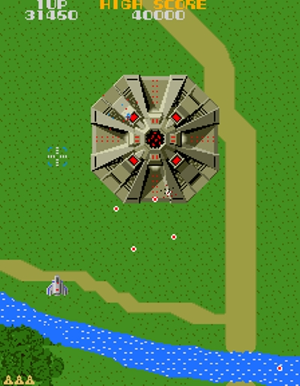
Interestingly enough, there are certain ground targets that pose no immediate threat, but can still be destroyed anyway. Of particular note, is the Zolback ground unit- a small dome with four glowing red stripes around the top of it. While they cause you no harm, they do serve as radar installations that give away your position to the enemy. Failing to destroy the Zolbak radar units result in an increasing number of aerial forces attacking you. On the other hand, if you do destroy them, aggression from the enemy will momentarily lighten. Features like this are what made the game stand out in terms of ingenuity.
This was also one of the first games to have hidden bonuses. By performing a special maneuver at the start of the game, you can unlock a secret message from Namco. The most memorable bonus for me has always been those hidden “S” flags from Rally-X. You can reveal them by bombing the correct areas of the terrain. Collecting one of those flags net you a nifty 1-Up; something you can never have enough of in this game. You can also uncover secret Zol towers strewn about by using the same technique for finding “S” flags. Revealing a Zol tower nets you 2000 points and destroying it awards you with an additional 2000 points to your score. It’s great for quickly gaining points needed for an extra ship.
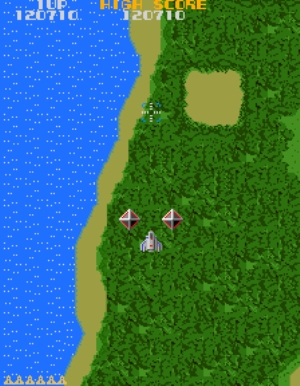
My only real criticism of Xevious is that your ship is a little too slow compared to the enemies’ bullets being fired. It’s really easy to get caught in their crossfire if you’re not mindful of your position on the screen, which can cheapen the joy of gaining an extra life in the first place. Certain enemies have tricky flight patterns. It can be hard to evade them when they attack in swarms while also dodging other hazards as well. It is especially troublesome evading bullets while flying over large bodies of water because the enemy shots tend to blend in with the blue and dots of white used for the water graphics. It’s a real pet peeve of mine because, in those scenarios, I often find myself second-guessing where to position my already-too-slow ship, losing my groove of concentration, and catching a bullet of death as a result. Not my preferred way to go.
The visual style presented in Xevious was something truly unique to the genre. Instead of a mere blank background or simplistic star field, the action takes place over an Earth-like landscape. You can easily tell the difference between grassy, dirt, aquatic, and forest terrain. The character pixels were rendered through the careful use of grey colors and a method called palette-shifting. This resulted in each enemy having smooth, realistic animations with a clarity that was revolutionary for its time.
Arcade games running on the Namco Galaga system hardware were known for delivering high-quality audio and Xevious was no exception. The sounds effects were quite unique for the genre back then also. Destroyed aerial enemies made a noise that I can only describe as tiny glassy objects shattering. A realistic “BOOM” emits from defeated ground targets. The Andor Genesis base eerily hums as it drifts backward firing a hail of bullets at you. The musical score is one of the earliest examples of a consistent tune playing throughout the course of the game. Admittedly, it’s extremely repetitive and outdated by today’s standards, but it still pioneered the idea that later mushroomed into full-blown soundtracks in future arcade shooter titles.
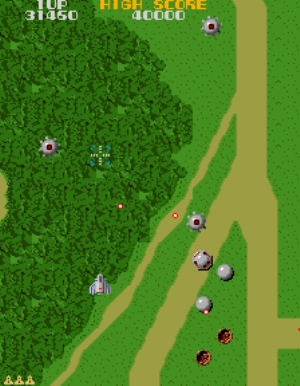
The innovative design work that went into Xevious had a profound effect on the shoot ‘em up genre. Many elements of the game would go on to serve as a template for future vertical and side-scrolling shooters that, in turn, would also become major hits for the developers. In some cases, sub-genres would even be born from some of these elements. Konami’s Twinbee series makes liberal use of dedicated buttons air and ground attached respectively. Taito would later use a similar method to even greater effect in its Ray series (replace Xevious’ bombs with awesome swirling lasers). And countless of other shooter series followed Xevious’ lead with the use of familiar Earth locations and scenery.
While the scrolling speed is rather slow, Xevious still a nice game to experience if you’re into the classics. The original arcade version of this game is still fairly easy to find as it’s been included in multiple Namco Museum compilations on nearly every major home console (and handhelds) since the mid-90s, continuing into the present day. It’s a nice piece of gaming history to own.
Special thanks to shmuplations.com for providing the source of the Xevious interview with Masanobu Endo. It’s a fascinating read which you can check out here.
Xevious went on to be ported to just about every home console known to man well into the late 80s. Suffice it to say, it lived well beyond its introduction to the arcades. Perhaps a little too long in the eyes of Nintendo consumers. Released in 1988, the NES port of Xevious gets a bad rep by and large. Essentially, the functionality was exactly the same as the arcade version-- and that was exactly the problem. By the time found its way over to Nintendo’s home console, other arcade ports like Gradius, Life Force (Salamander in Japan), and 1943 were either released previous to or very soon after Xevious’ arrival. These games featured customizable weapon choices, faster action, and generally deeper gameplay elements.
Truth be told, Xevious was looking a bit dated next to the competition on that system. And the game’s severely reduced visual quality didn’t help much either. Remember-- this was before retro gaming had become a culture phenomenon (at least, not in a form universally acknowledged), and SHMUP fans were still looking forward to the bigger and better shooters out there. At face value, this port of Xevious isn’t a bad game per se, but it could have used a few bells and whistles considering the amount of time that had passed between its original arcade debut and its release on the NES.














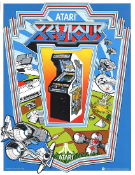

Side By Side - The NES version